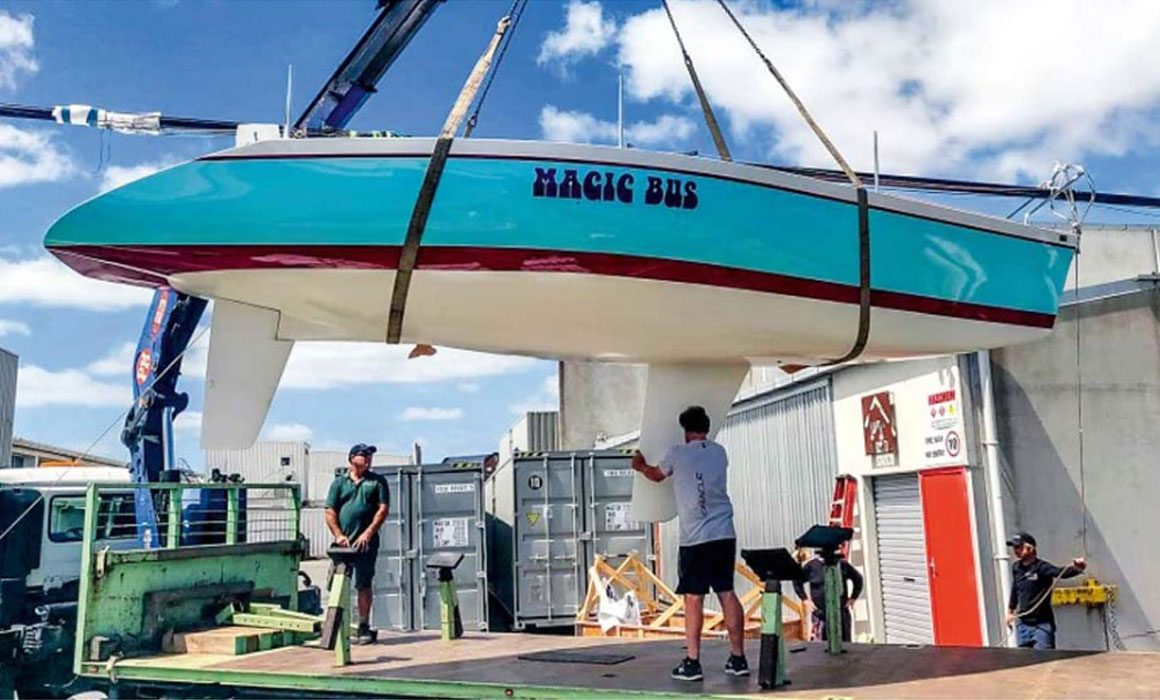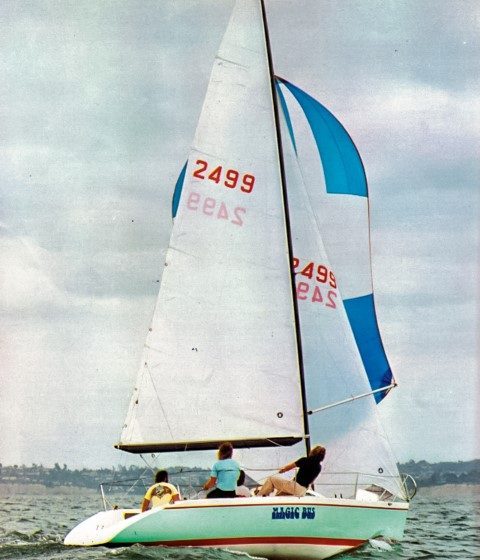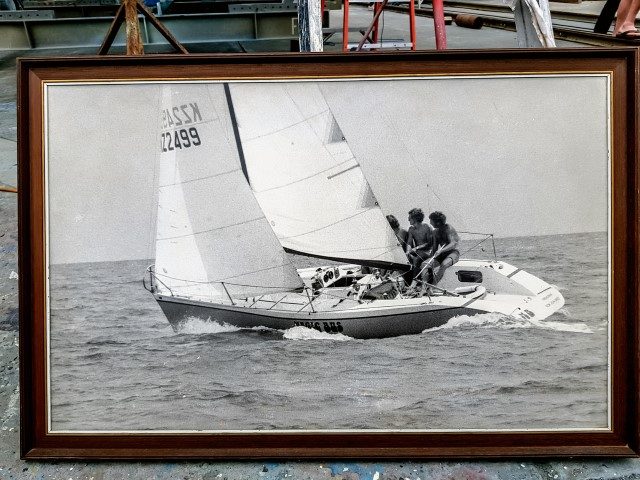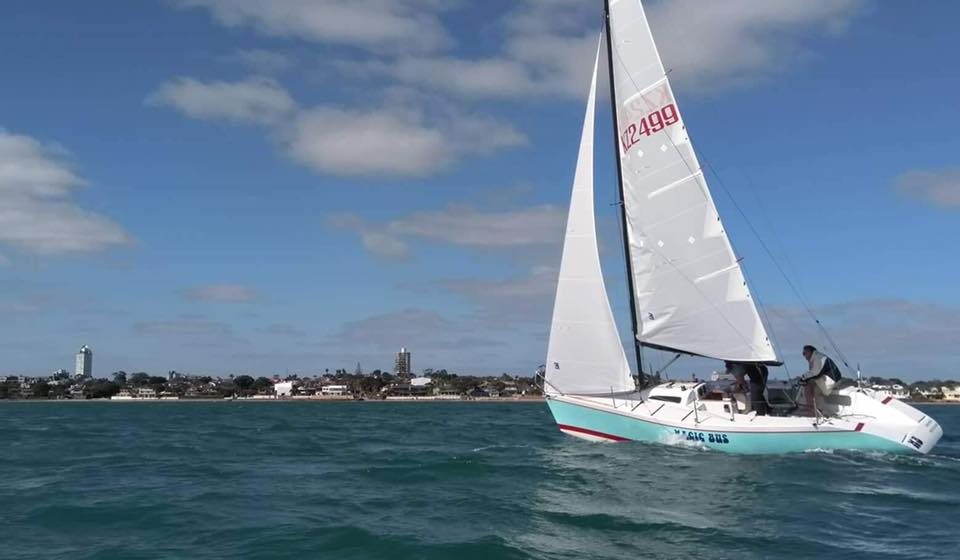

North Shore boatbuilder and sailor Dave Hurley has undertaken a labour of love to bring a modern classic back to life.
In the 1960s and 70s, New Zealand was emerging on the international yachting scene, as designers, builders and sailors took on the establishment with a new wave of super-fast light displacement flyers. Following the world-beating exploits of Chris Bouzaid and Rainbow II, a Sparkman & Stephens design built by Max Carter which won the One Ton Cup in 1969, a new generation of designs explored and exploited rating rules to challenge the world.
Among them was Magic Bus, a bright-blue Quarter Tonner designed by one of the most talented of the new breed of designers, Aucklander Paul Whiting. Even by his early 20s, Whiting had a strong track record, having designed and campaigned the first of the popular Reactor class while still at high school. In 1976, he teamed with dinghy sailor Murray Ross to challenge for the 1976 Quarter Ton Cup in Corpus Christi, Texas.

With her distinctive turquoise and maroon paint job and IOR-optimised hull shape, the Bus was 7.8m LOA and 6m on the waterline, with a 2.7m beam in her flared midsection. All systems were designed to minimise weight and windage and, with nothing inside her she weighed just 1180kg.
The combination of super-light construction, clever design and masterful sailing by Ross, Whiting, Steven Allen and bowman Steve Trevurza saw the Bus win the world championship, taking out every race but one. The yacht spawned a production class back here in New Zealand, but the original was sold in America and lost to the world of Kiwi sailing – until Dave Hurley came along.
Hurley, whose track record of sailing and boatbuilding for America’s Cup teams stretches back to 1988, says the restoration came about after one of those conversations between mates.
“One day we were sitting around talking about the restoration of Rainbow II [relaunched in 2015] and what a great job it was, and I made the comment that if I had the money I’d love to do something like that. I couldn’t afford to do a One Tonner or a Half – it would have to be a Quarter.”
When it came to which Quarter Tonner, Hurley says it was a no-brainer: it had to be Magic Bus, with her world-beating record. But first they had to find her. After much poking around social media and other avenues of the internet, young boatbuilder James Berry discovered her last race had been out of the Alameda Yacht Club, on the western side of San Francisco Bay, and found a photo on a blog of her sitting in an unidentified boatyard.
Berry then tracked down the owner of the Laurie Davidson Quarter Tonner Fun, which finished second to Magic Bus in 1976. “We thought that owner might know where Magic Bus was, so we rang up and asked, and he said ‘I walk past it every day’,” says Hurley.

Hurley, who had just returned from working on Oracle’s 2013 campaign in San Francisco, rang some people he knew who worked for the Artemis team who were still on the ground, and sent them down to check it out. The boat had been deemed abandoned so a deal was done, and Magic Bus was on her way home.
She was in a very neglected state, with rot in her plywood foredeck and cockpit, which needed to be replaced, and some delamination in her pioneering foam and glass hull. Forty years on, she still had some of her original electronics and deck gear, although several items have had to be replaced since her relaunching (including the spinnaker pole, broken in a Chinese gybe).
“She still had the original mast, in a terrible state,” Hurley says. “Trevor Berry, who was a good friend of Paul Whiting’s, rebuilt the rig for us.”
Other supporters of the rebuild were Oceanbridge, Touch of Gloss, ID Sign, Harken, Dixon Stainless, Plytech, Transconn, the Shann Group, NZ Composites, Boat Haulage, Adhesive Technologies, MS Engineering and Anzor. A new suit of sails was built with the support of Dimension-Polyant by Dave Parr of Calibre, with the new/old boat boasting a new main, number one, two and three jibs, and a new spinnaker.

Consulting on the rig and sail set-up was original bowman Steve Trevurza, who hadn’t seen the boat since the Corpus Christi regatta 40 years earlier. Now based in Australia, Trevurza visited during the restoration and was present when the boat was slipped back into the water at the Milford Cruising Club boatyard in the Wairau Creek on Auckland’s North Shore in November 2018.
“It’s been a massive collaboration of the New Zealand marine industry,” Hurley says. “I’ve done all the work, but they have supplied all the equipment, as well as helping to get the boat back from the US. It’s been a big, group love-fest – everyone has been touched by the project.”
One of the biggest challenges of the restoration was working out how much of the boat was original and what was a later addition, and deciding what to restore and what to replace.
“I spent a lot of time on the internet looking at old photos,” he says. “Tony Whiting [Paul’s brother] gave me some old drawings of the Bus and we found the original deck layout – all handdrawn. One of the biggest highlights was going to see Tony and him pulling out these drawings and going through them.”
The Whiting family also helped out with details of the restoration, including finding an old locker lid from family yacht Tequila which had been painted with the same batch of mixed-up paint that provided Magic Bus’s unique colour, so it could be matched.
The restoration was particularly close to the hearts of the Whitings. Paul Whiting was just 27 when he was lost at sea in early 1980, along with his wife Alison and crewmen John Sugden and Scott Coombes, when his yacht Smackwater Jack was hit by a cyclone while returning from the 1979 Sydney– Hobart race.

Sister Debbie Whiting attended the relaunch and spoke “on behalf of the Whiting family who are here, the ones who couldn’t be here and the ones who are no longer here”, to thank Hurley “for keeping Paul’s dream alive”. She presented him with an American ensign ‘souvenired’ by Paul Whiting following his victory, and the boat’s original mascot, Tex the Bear.
“Dave has done an absolutely amazing job,” Debbie Whiting says. “I was in Corpus Christi in ’76 when it won the Quarter Ton Cup, which was an incredible experience – Magic Bus had it all over the other boats, other than in the long race, when one of the other boats took their garbage bag instead of their food bag, so they didn’t have any food and were first to finish out of necessity!”
Now Magic Bus is back in the water, it’s been up to Hurley and his crew to work out how to sail her to her full potential. Ross and Whiting clearly knew how to get the best out of her, but Hurley says she’s not an easy boat to sail, and never performed as well again for any of her new owners.
“She’s a very difficult boat to get into the groove, because of the systems on her, but we’ve felt it get there a few times and it’s just outstanding,” he says. “Obviously those guys knew how to keep it there all the time.”
While Hurley is enjoying finally getting out of the workshop and out sailing on his pet project, he is looking for a long-term home for her, hoping a maritime museum or heritage trust might take on this modern classic.
“Our designers were the top of the world at that time, when there was a major shift in the way boats were being designed and built. This boat is a shining example of that – light, and tweaky as hell,” he says.
“New Zealand designers looked outside the box and went against the mainstream designers of the time from the US and Europe, who were more conservative. Paul was a leader in light displacement – he was radical and pushed rules to their absolute maximum. Some people don’t like that, but that’s what designers are supposed to do. They are commissioned to make boats as fast as possible.”




